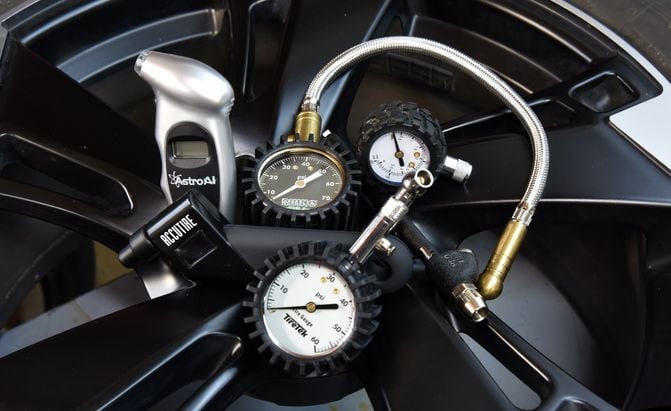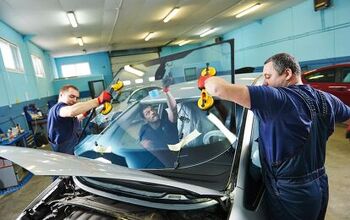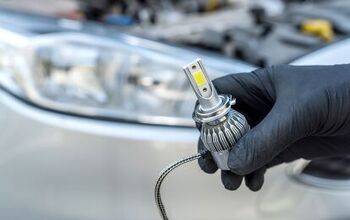The Best Tire Pressure Gauges to Keep Your Tires Happy

Every car owner should include one of the best tire pressure gauges in their toolkit. Keeping your tires properly inflated ensures they wear evenly, and that you’re getting the best possible gas mileage. It’s a small investment that will keep you from having to replace your expensive tires too soon, and save money on every fill up.
According to the US Environmental Protection agency, the average tire is underinflated by 1.8 PSI (1.1 PSI in front and 2.8 PSI in back), and for every pound of pressure too low, you lose 0.4% in fuel economy, or 0.7% on average. Doesn’t sound like much? That’s like paying 3¢ more a gallon, 30¢ more for a 10 gallon fill-up…or $168 a year for the average driver. That makes spending 20 bucks on the best tire gauge you can get (and a great inflator) a lot easier to take, especially when you only have to buy it once.
You can’t see a tire that’s a couple of pounds low by eye, because radial tires don’t start to look low until they’re about 5 PSI down on air, which going back to our numbers above is starting to make a real dent in your wallet. And if you haven’t noticed, not just gas but tire prices are climbing, and low tire pressure makes them wear out faster. You’re even more likely to get a puncture and a flat with low tires.
Choosing the Right Tire Gauge For You
Tire air pressure gauges are available in pencil, analog (dial) face, and digital, and they all have advantages and disadvantages. A quality pencil style gauge won’t cost much and will last for decades, but they’re harder to read and not the most accurate, usually with 2.0 PSI increments. A calibrated dial gauge is the most accurate in this price range (race teams use super accurate digital gauges that cost hundreds of dollars), and usually most expensive. They often have hoses attached, so you don’t have to put your face as close to the tire valve. Some come with convenient deflators built in. Digital tire gauges are easy to use and the easiest to read, but you usually have to pay more for one with certified calibration. The inexpensive ones are a commodity product, made by a few different factories in a handful of styles, then sold with small cosmetic changes as different brands. We’re going testing more them to see if there’s a real reason to choose one over the other.
Take a look at our picks for the best tire gauges below, and see our Table of Contents for lots of tips on use and proper tire inflation.
Table of contents
- 1. Editor's Pick: Rhino USA Heavy Duty Tire Pressure Gauge
- 2. Foolproof choice: Dill Dual Foot Black Pencil Tire Air Gauge
- 3. Best Digital Gauge: AstroAI Digital Tire Pressure Gauge
- 4. Most Accurate: TireTek Premium Tire Pressure Gauge
- 5. JACO ElitePro Tire Pressure
- 6. Milton S-291 Passenger Tire Gauge
- 7. The Professional Choice: Longacre 52-52000 Pro Precision Tire Gauge
- Everything You Need to Know About Tire Pressure
- How Do I Know If My Tires are Properly Inflated?
- Why is Proper Inflation Important?
- How To Check Your Tire Pressure
- How Often Should I Check My Tire Pressure?
- How Do I Use A Tire Pressure Gauge?
- Is It Safe To Drive My Car with Low Tire Pressure?
- Recent Updates:
1. Editor's Pick: Rhino USA Heavy Duty Tire Pressure Gauge
After testing seven pressure gauges, and drawing on the experience of our editors, our Editor's Pick is the Rhino USA 75 PSI Heavy Duty Tire Pressure Gauge. It features a 16.75-inch braided hose and chuck assembly, 2.0-inch glow-in-the-dark high contrast dial with 0.3-inch protective rubber bumpers, and solid brass hardware. It's calibrated to the ANSI B40.1 standard, but they didn't list the grade, which tells you the permissible error across the range. We found it to be within 1.0 PSI of the other gauges in our test.
This was the most versatile gauge we tried, with a swivel connection at both the chuck, and at the body of the dial. That made it easy to get one end on the valve stem, and the other where it is convenient to read. Like many dial gauges, it holds the reading after you remove it from the tire, with an air pressure relief valve that doubles as a deflator, if a very slow one. It's the largest tire gauge in our list, however, which makes it a lot less convenient to jam into a glovebox. It does come with a drawstring bag to protect the face from scratches, and a package of stickers and decals, if that's your thing. The Rhino USA Heavy Duty Tire Pressure Gauge has an excellent 92% positive rating and over 4,600 reviews.
It's worth noting that while we received a braided metal hose, Rhino USA has switched to a braided fabric covered one, which we prefer, as fabric is less likely to kink in the long run.
Rhino USA Warranty and Customer Service
Rhino USA offers a great no-hassle unlimited lifetime warranty on all their products. There is a toll-free customer service number and email on the Rhino website, and they welcome customers at their Murrieta, California, offices. When we called anonymously, someone picked up on the first ring, answered all our questions, and offered to replace our gauge for free, even though there was nothing wrong with it.
Pros | Outstanding customer service, long hose, solid brass hardware, 360-degree swivel chuck, lifetime warranty |
Cons | Price, only reads up to 75 PSI |
2. Foolproof choice: Dill Dual Foot Black Pencil Tire Air Gauge
When we spent our own money on an air gauge, it was on the Dill. We've found a lot of tire gauges are actually the same product, made by the same offshore factory, with a different name and maybe color slapped on them. Dill makes their own, in the USA, and the fact that it weighs almost half a pound tells you it's not a disposable piece of plastic. A dual-foot gauge, which reads either straight or at a 30° angle, is very useful for reaching inconveniently-placed valves, which in our experience is most of them. It's rated for truck tires and reads from 20 to 120 PSI in two PSI increments on a plastic gauge. That's the only plastic part of it, the rest is solid metal. There are more accurate pencil gauges available that read down to 5 PSI and top out at 50 PSI, if you don't need the high end of the range. See our pick for one of those lower down.
We have about a half-dozen tire pressure gauges in the AutoGuide Garage, and we end up reaching for the Dill for most routine needs. It's very gratifying to grab this chunk of metal, and it couldn't be easier to use. It doesn't make the top spot because dial gauges tend to be more accurate than pencil style and are easier to read. Our top pick comes with a built-in deflator, which we use a lot in other tests, but if it doesn't apply to you, the Dill air pressure gauge is likely to be the only one you'll need during your lifetime.
This air gauge wouldn't normally qualify for inclusion on our recommendations, because while it has an 83% positive rating, there are only 26 reviews. However, our personal experience with these—not to mention that of thousands of mechanics—says says you're not going to be disappointed.
Dill Warranty and Customer Service
Dill Air Controls Products has been making tire parts and gauges in the USA since 1909 and if for some reason you need customer service on a $10 tire air gauge, the Dill website has an 800-number (and driving directions, if you want to visit) for the headquarters in Oxford, North Carolina; as well as a fax number and web form. There's a 60-day warranty on the tire gauge.
Pros | Built for life, little to go wrong, reads to 120 PSI |
Cons | Not as precise or easy to read as a mechanical dial, no deflator |
3. Best Digital Gauge: AstroAI Digital Tire Pressure Gauge
The AstroAI Digital Tire Pressure Gauge is the best digital gauge we tested. The bright illumination and accurate readings make it better than other gauges in its price range. It features blue backlit LCD and matte finish grip. The best feature is a bright LED circling the chuck, which makes it easier to find the valve stem. It reads in 0.5 PSI increments, has has setting for 0-150 PSI, 0-10 BAR, 0-10 kgf/cm2, or 0-1000 KPA. It uses a single button for all its features, toggling on/off, and the unit of measurement. The device will automatically shut off after 30 to 40 seconds to save power. A non-replaceable battery* is included.
This gauge read within the rated 0.5 PSI of our other gauges and it was easy to see the display. But it sometimes took several tries to get it to take a reading, and it was easy to hit the power button and lose our measurement. The blue light is very bright, but we'd rather have white for the chuck flashlight, and red (or anything but blue) for the gauge for the sake of preserving our vision at night. This gauge has over 48,000 reviews and a very good 89% positive rating.
AstroAI Warranty and Customer Service
AstroAI offers a 30-day guarantee and one-year warranty on their product. They have a toll-free number, local California number, and customer support email on their site, along with easy-to-find user manuals. Customers report that warranty service is easy to use.
* You could pry it open and replace the batteries, but it takes one CR2032 and three LR44 button cell batteries, and there are some plastic tabs it's easy to break. If you're not a fan of disposable culture, be prepared to do some gluing or use small screws during reassembly.
Pros | One year warranty, good customer service, large pressure range, auto shutoff, light and easy to use |
Cons | Short display time, disposable, blue isn't a good color for night use |
4. Most Accurate: TireTek Premium Tire Pressure Gauge
Of all the gauges we tested, only TireTek lists the grade of ANSI B40.1 calibration, Grade B, which is the highest standard for consumer and commercial gauges. That means it's rated for 3% accuracy, or ±1.2 PSI, from 15 to 45 PSI. Other gauges might be as accurate, and others in the AutoGuide Garage performed equally well, but without publishing the grading, you have no way of knowing. If it was as convenient to use as our top pick, it would be in the running for the #1 spot on our list.
Like most mechanical dial tire pressure gauges, it holds pressure and it's reading until you release a valve. This lets you measure on the tire, but without the need to get your face down close to the valve stem. The two-inch face is surrounded by the typical rubber drop guard, and the rest of the construction is steel and plated brass. The face glows in the dark, but you need to shine a bright light on it first, so it won't work straight out of the glovebox. As 45-degree swiveling 5 mm chuck is more usable than a straight one, but it can be hard to get into some tight wheels. If you don't have the room for our top pick, this is a good choice for accuracy and dependability, and it has an excellent 92% positive rating from over 5,500 reviews.
TireTek Warranty and Customer Service
TireTek gauges have a 12 month warranty, which you can extend to a lifetime satisfaction warranty by registering your product on the TireTek site. There is a web form and customer service email, but no phone number.
Pros | Lifetime warranty, 360-degree swivel chuck, Grade B calibration |
Cons | Can be hard to reach some valves, needs light to glow |
5. JACO ElitePro Tire Pressure Gauge
JACO is a top-quality product but falls down the list with a lack of customer service.
JACO produces a high-quality mechanical dial gauge similar to Rhino, and at about the same price. The ElitePro tire pressure gauge is calibrated to ANSI B40.1 standard and promises ±1.5% accuracy without having to rely on batteries. Manufactured with premium heavy duty components, the gauge is surrounded by a rugged, gear-style guard and has a flexible 10 inch rubberized no-leak air hose. There is a built-in bleeder valve to reduce pressure in overinflated tires, while the 360-degree chuck makes it easy to access your valve stems.
The two-inch dial reads up to 100 PSI and glows in the dark, while readings are locked in place until the pressure reset button is pushed. We like the high-contrast, two-inch dial for readability. It has a terrific 93% positive rating from 5,700 reviews.
JACO Warranty and Customer Service
JACO Superior Products offers a 30 day money back satisfaction guarantee and lifetime warranty on their product ElitePro gauge. When we called them, there was a message saying JACO didn't have phone support "this week," but we don't know how old the message was. We'll check back later to see if that changes, but for now there is just a web form and email on the site. This keeps the ElitePro out of contention for a top spot on our list, even if functionally it's very competitive.
Pros | Lifetime warranty, quality materials, 360-degree swivel chuck, high-contrast glow-in-the-dark dial |
Cons | Questionable customer service |
6. Milton S-291 Passenger Tire Gauge
If you like cars, this is one of those tools that you should own at least once in your life. Milton has sold untold millions of their classic pencil gauge over the years, and with good reason. This US-made, plated brass single chuck head pencil tire pressure gauge is just about the cheapest way to get the job done reliably.
This old standard measures 5-50 PSI in 1 PSI increments on two faces of the gauge, and 40-350 kPa in 10 kPa increments on the other. Milton Industries doesn't state how accurate the gauge is, but ±1 PSI is probably a safe bet, which puts it in the middle for accuracy. The head is at a good angle for taking readings, shallower than the 45° on most other gauges. You'll need to check your measurement two or three times to be sure you got full pressure into the gauge, until you get used to it. The markings are legible but small, and exposure to any solvent, like brake cleaner, will remove them. The Milton S-291 Passenger Tire Gauge has a very good 90% positive rating across almost 4,500 reviews.
Milton Warranty and Customer Service
We wouldn't expect most people to feel compelled to make a warranty claim for a tire gauge you can pick up almost anywhere for under $10, but Milton Industries has a 15-day money back satisfaction guarantee, and one-year limited warranty on defects. You can submit the warranty claim through a web form on the Milton site, and there is a toll-free number and other web forms on the Milton site. You can also register your gauge with Milton, if you wish.
Pros | Price, durable plated brass construction, built-in deflator knob |
Cons | Only measures to 50 PSI, hard to read, especially when it gets greasy, not as accurate as a good dial gauge |
7. The Professional Choice: Longacre 52-52000 Pro Precision Tire Gauge
You aren't going to see a Longacre in most garages, or even tire shops, but if you need the most accurate and legible tire gauge this side of the aerospace industry, there aren't too many other choices. Where you will find them is in places that build and race cars.
This massive USA-made gauge sports a 4.5 inch face, and is marked in 0.5 PSI increments from 0-60, which makes sense when you consider its lab-quality 0.5% (0.25 PSI) accuracy for the entire range of the gauge, or ASME B40.1 Grade 2A. It has a high grade 17-inch hose and comes with both a straight 45° swivel angle chuck and a swivel ball chuck, not to mention a padded metal carrying case. It also has dual pressure release buttons to make it useful for controlled deflating.
This is complete overkill for any commuter car and you could buy a case of any of the other gauges on our list for less than the Longacre Pro Precision, but it's vital equipment for places like race shops where every half a PSI matters. You're also not going to find many reviews for a product like this, although those it has are 100% positive. Their products lower down the product stack are all in the 92-95% positive range, with thousands of reviews.
Longacre Warranty and Customer Service
We're not sure why a premium product like this only has a one-year warranty, other than they make expect them to have hard use trackside. They do offer a repair service and are very easy to contact, with multiple toll-free and local Indiana phone numbers, emails, and web forms on their site. They answered our call on the first ring, and answered our questions immediately.
Pros | Huge, easy to read gauge face and incredible accuracy |
Cons | Costs more than some tires, disappointing warranty |
Everything You Need to Know About Tire Pressure
Often overlooked and even sometimes forgotten, your car’s tire pressure is an important factor in making sure your car runs optimally. These days, most modern vehicles come equipped with Tire Pressure Monitoring Systems (TPMS), which takes the guesswork out of wondering whether your car’s tire pressure is low or not. But what if your car doesn’t have TPMS? And if it does, are there still things you should know?
You may be surprised by how great of an effect your car’s tire pressure has on your vehicle’s performance. In fact, if you’ve noticed that your gas mileage has gone down a few MPG, it’s likely attributed to your car’s tires.
How Do I Know If My Tires are Properly Inflated?
Even if your car is equipped with TPMS, you will want to know the recommended tire pressure for your specific vehicle. Typically, there is a sticker found inside the driver’s side door that will list the recommended tire pressure. This figure is normally indicated in PSI, which stands for pounds per square inch of air. In addition, your tire’s maximum air pressure will be labeled on the tire’s sidewall. That figure is the maximum PSI the tire can safely hold. In other words, don’t inflate your tires beyond the number found on the sidewall.
If you are not able to locate a sticker on the inside of your driver’s side door, refer to the owner’s manual to determine the recommended tire pressure for your car.
Keep in mind that the recommended tire pressure values could be different between your front and rear tires. Make sure you’re checking both front and rear values when you’re determining whether your tires are properly inflated.
Why is Proper Inflation Important?
There’s a reason why vehicles have recommended tire pressures. Proper inflation of your car’s tires not only ensures it’s comfortable to drive and ride in, but it can also affect your fuel economy. More importantly, they ensure your tires are wearing out uniformly, extending the life of your tires.
Overinflating or underinflating your tires could have adverse effects on its performance. Not only do underinflated tires appear flatter, they have increased surface contact with the road. If driven over a long period of time, that contact can result in premature tire wear. Underinflation also has a direct effect on the car’s fuel economy.
Overinflating your tires with too much air can cause increased rigidity and stiffness, resulting in a harsher ride. Contact with the road is typically increased around the center area of the tire when it is overinflated, causing additional wear in the center. If you notice the sides or outer sections of your car’s tires are less worn out than the center, it’s a good chance they’re overinflated.
How To Check Your Tire Pressure
Checking your car’s tire pressure is a fairly straightforward and simple task. The easiest method is to use a tire pressure gauge that you can purchase online or at any automotive parts store for cheap. It’s normally recommended to check your car’s tire pressure levels when the tires are cold, or after the vehicle has been parked for at least three hours. Since friction causes heat, and heat increases tire pressure, doing a check after driving will likely give you an inaccurate figure. The recommended tire pressures you find in either the decal inside your driver’s side door or in your owner’s manual refers to the tire pressure before you start driving.
Using the tire pressure gauge, remove your valve stem cap and simply place the gauge on the stem with some pressure. A number will appear on the gauge, and it never hurts to check it two or even three times to make sure you have an accurate reading. Once you’ve checked the tire pressure on all four tires, make sure to replace the valve stem cap.
Avoid gauges like this one that don't hold a reading when you remove them from the valve stem. Photo credit: David Traver Adolphus / AutoGuide.com
If you don’t own a tire gauge, nearly all public air compressors will have an integrated tire gauge. More modern units at gas stations may have digital readouts to show your tire pressure. If your tire is overinflated, you’ll want to let some air out to get it back to the optimal PSI range. Make sure to check it periodically while you’re letting air out, so you don’t end up underinflating your tires.
How Often Should I Check My Tire Pressure?
With tire pressure monitoring (TPMS) required in new vehicles, many people don't think about tire pressure unless the light illuminates. Or maybe you go with the “eye test,” where you just look and gauge whether your tire is flat or not. But a TMPS light won't go on until your tires are about 20% low, far below the threshold to cost you gas money and wear out your tires.
Even in modern vehicles, you should check your tires (and oil!) at least once a week. It only takes a couple of minutes and is an easy way to stop problems before they start, and get to know your car better. Every time you drive, you should take 11 seconds to walk around your vehicle, especially if you’re taking a long trip. Then you can whip out your handy gauge if something looks off.
If you keep a tire gauge in your car, why not just do a quick check while you’re gassing up? It's something productive to do with that time and could go a long way in making sure your tires last as long as they should.
How Do I Use A Tire Pressure Gauge?
Tire gauges are easy to use, regardless of whether they're digital, dial, or pencil. Pencil tire gauges are typically compact and are a long thin tube with a chuck on one end to connect to the valve stem of your tire. As soon as you press it on and it gets air pressure from the tire, a plastic rod will extend from the gauge to show your PSI. If you’re using a pencil tire gauge, we recommended checking the tire pressure two or three times to make sure you have an accurate reading. When you're done, just push the rod back in. It should go in with almost no resistance, which also makes it easy to change by accident before you can look at it. Some pencil tire gauges will also allow you to let air out of your tire by putting the opposite end into the valve stem.
While they do cost a bit more than a conventional tire gauge, digital tire gauges are more reading and are easier to use. Some of them turn on automatically, while others have an on-off or multifunction button. Then, all you have to do is turn on the gauge and place it on the valve stem to get a PSI reading. But since they are digital, they’ll require batteries so always keep a spare set handy. If you're not using it every day, and it isn't alternately baking and freezing in your car, you should get at least three to five years out of a set of button batteries. A backlit screen is very handy for use under a dark car or at night, but they can wash out in sunlight.
We like dial gauges for everyday use. You know when you have a reading, because the indicator needle jumps when the gauge is pressurized. They have several advantages. Most of them hold pressure until you release it, so you have plenty of time to look at the number. They also tend to be large and easy to read, with two inch or larger dials. Many are glow in the dark and they don't need batteries, but they need light first if you want them to glow. Dial gauges can be very accurate and there's a calibration standard—look for those that say they meet ANSI B40.1, which is the highest standard of accuracy for consumer products.
Is It Safe To Drive My Car with Low Tire Pressure?
We don't recommend driving your car for an extended period of time with low tire pressure. If your vehicle is equipped with TPMS and the light is on, you’ll want to address the issue as soon as possible. Low tire pressure not only results in uneven wear on the tire, it increases the risk of getting a flat or even a blowout.
Recent Updates:
July 18, 2023: Removed Temkin gauge due to availability.
July 11, 2023: Added Temkin gauge.
January 3, 2023: Removed promoted product recommendation.
April 6, 2022: Updated introduction, minor corrections.
March 14, 2022: Updated information for Rhino USA Heavy Duty Tire Pressure Gauge.
March 11, 2022: Updated FAQs and photos. Updated information for JACO ElitePro and Milton S-921 tire pressure gauges.
March 10, 2022: Added hands-on review and photo of Rhino USA Heavy Duty Tire Pressure Gauge. Awarded "Best Digital" to AstroAI Digital Tire Pressure Gauge and updated review and photo based on testing. Moved TireTek gauge to 4th place and added testing results and photo. Moved Accutire to 5th place and added testing results and photo. Updated FAQs. Removed Slime Digital Tire Gauge, added Longacre 52-52000.
We are committed to finding, researching, and recommending the best products. We earn commissions from purchases you make using the retail links in our product reviews. Learn more about how this works.
AutoGuide may accept review samples for testing and evaluation. Suppliers of review products do not have any input into our conclusions and are not allowed to review our content before publication.
Photo credit: David Traver Adolphus / AutoGuide.com

After completing a degree project in automotive design, Dave wrote and photographed for almost a decade in print car magazines (remember those?), before transitioning to digital. He now subjects a series of old high-performance cars to the roads and weather in Vermont and wonders why they're always expensively broken. Please stop when you see him crawling under one on the side of the road.
More by David Traver Adolphus








































Comments
Join the conversation
If all I had in my tire care kit were Longacre Analogs and a couple of 921s by Milton, I'd be set for life. I've found that with digital gauges, such as the Jaco Elite and Longacre Basic Digital that I own, I never get the same reading twice!! Bleed air down & check: "32.0" Remove. Recheck: "31.9" Recheck: "32.2", and so on. GRRRrrr! :D With the analogs, I get the same reading repeatedly. Of course, if I checked a tire five times in a row, I would notice a downward trend in the reading, particularly with the Milton stick(plunger) gauge, as air is repeatedly sacrificed from that tire. Double-checking cold pressure, with any gauge, should be confident enough. More than what gauge, it's how much TIME you put into adjusting pressure at each tire that determines how precisely it gets set. Short quick bleeds on gauges with a bleeder valve are better than one long bleed, down to your goal pressure. Something minor I did notice when airing down to spec with the Longacre Deluxe analogs(a 60 and a 40psi model) I own: When I arrive at my target pressure, I noticed the that the needle will creep very slowly up, after I last press the air bleed button. No more than up to quarter PSI above target hashmark, eyeballing it. So it is OK to bleed down until that pointer is about a hair below your target pressure, and hold it on the tire valve to see the pointer creep up to cover the hashmark representing your pressure. After setting my particular car's pressures(32psi) with the above procedure with the 40psi Longacre DeLuxe, and taking the time to allow for that pointer 'creep', I verified my work with the Jaco Elitepro digital: Two tires were 32.0psi, and two were 32.1psi. THAT is why Longacre Racing is Longacre racing! Too bad you can't just walk into a place and buy them. Just do yourself a favor: Keep the Longacre kits indoors, and the Milton plunger sticks in your glove compartment or arm rest console. Those Longacres are investments, not to be tossed about casually.
Don't be upset when your digital gauge reads to the 10th and that number is different between readings. With your analog gauge you are reading to a line of 1 or 2 pound increments, You guessing at everything in between the lines. Digits beyond the decimal point mess with your mind. They are always moving.